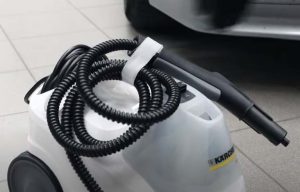A clean engine not only operates more efficiently but also extends the life of your vehicle. Over time, dust, grease, and road debris accumulate in the engine compartment, which can lead to reduced performance and efficiency. Learning how to steam clean engine parts can effectively tackle this issue, ensuring that your engine operates in peak condition. This comprehensive guide will take you through the detailed steps involved in steam cleaning your engine, helping you to maintain your vehicle’s performance and longevity. Embracing a routine engine cleaning schedule can save you time and money on future repairs and issues related to dirt and grime buildup.
The Basics of Steam Cleaning
Steam cleaning uses vaporized water to clean, sanitize, and remove grime from various surfaces. This method has gained immense popularity in various cleaning tasks due to its efficiency and the absence of harmful chemicals. Steam cleaning is exceptionally advantageous for engines because the steam can easily reach narrow and intricate parts, ensuring a thorough cleaning. Moreover, the high temperature of steam not only cleans but also sanitizes the engine components, reducing the possibility of microbial growth and resulting damage. Understanding the basics is crucial before you delve into the specifics of how to steam clean engine components.
Preparing the Engine for Steam Cleaning
 Proper preparation is crucial for the successful steam cleaning of your engine. First, ensure the engine is cool to prevent the risk of burns or rapid evaporation of the steam. After that, use a brush or compressed air to eliminate loose debris from the engine compartment. It’s essential to cover or shield all the electrical components, including the battery, alternator, and spark plug wires, to avoid water-related damage. Proper preparation is fundamental for an effective steam cleaning process, ensuring that your engine gets cleaned without causing any inadvertent damage.
Proper preparation is crucial for the successful steam cleaning of your engine. First, ensure the engine is cool to prevent the risk of burns or rapid evaporation of the steam. After that, use a brush or compressed air to eliminate loose debris from the engine compartment. It’s essential to cover or shield all the electrical components, including the battery, alternator, and spark plug wires, to avoid water-related damage. Proper preparation is fundamental for an effective steam cleaning process, ensuring that your engine gets cleaned without causing any inadvertent damage.
Steps to Steam Clean Your Engine
Before starting the steam cleaning process, ensure that your steam cleaner is in good working condition and follow the manufacturer’s instructions for its operation. Here are the structured steps to execute the task:
-
Fill the Steam Cleaner: Use distilled water to fill the steam cleaner. Avoid using regular tap water as it may contain minerals that can cause build-up within the steam cleaner.
-
Heat Up the Steam Cleaner: Allow the cleaner to heat up as per the manufacturer’s guidelines. It’s important to wait for the steam cleaner to reach the appropriate temperature to ensure effective cleaning.
-
Clean the Engine: Begin at the top of the engine, systematically working your way downwards. Make sure to cover every nook and cranny to ensure all dirt and grime are removed. The vaporized water will break down the tough stains and debris.
-
Wipe Away the Dirt: Use a clean microfiber cloth to wipe away loosened grime and excess moisture as you clean each section. This will help in preventing the dirt from resettling on the engine components.
-
Let the Engine Dry: Allow the engine to dry thoroughly. This step is crucial to avoid any water-related damages. Use compressed air to expedite the drying process or let it air dry naturally.
Consistently following these steps will ensure that your engine is effectively cleaned, leading to enhanced performance and longevity.
Post-Cleaning Steps and Maintenance
After learning how to steam clean engine and completing the process, the next phase involves post-cleaning steps and maintenance. Conduct a meticulous inspection of the engine and its components. Ensure everything is intact, and no water has permeated unwanted areas. It’s important to ensure that all seals, hoses, and connections are secure and undamaged. Start the vehicle and let it run for a few minutes to make certain that everything operates seamlessly. In addition, perform regular maintenance checks on your vehicle. Schedule timely oil changes, and don’t forget to replace air filters to maintain the overall health and performance of the engine. Speaking of performance, it’s also worth noting the benefits of upgrading to the Best Cold Air Intake for Vortec Engines. This upgrade can significantly boost your engine’s efficiency.
Conclusion: The Value of a Clean Engine
In wrapping up, understanding and implementing the techniques on how to steam clean engine components stands out as a crucial competency for vehicle owners and enthusiasts alike. A consistently clean engine guarantees optimal operation, diminishing the likelihood of unexpected breakdowns and costly repairs. It acts as a proactive approach in maintaining the mechanical integrity of your vehicle, assuring you of reliable performance and extended vehicle lifespan. Moreover, it contributes to the overall efficiency and effectiveness of the engine, ensuring that each ride is smooth and unproblematic. Delve into the world of efficient and eco-friendly cleaning by making steam cleaning a regular part of your vehicle maintenance routine. Beyond a doubt, a clean engine is synonymous with superior performance and enduring vehicle life, reinforcing the significance of regular and effective engine cleaning in preserving the prime condition and performance of your vehicle.


Add Comment